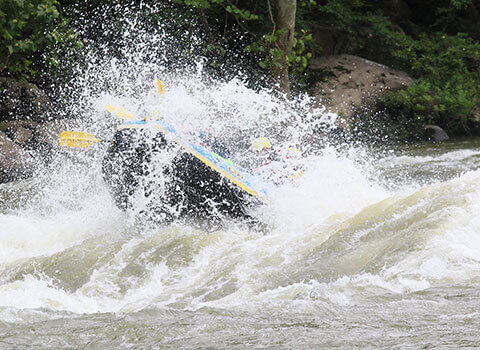Summer brings longer days, lots of sunshine, whitewater rafting, and sometimes, unfortunately sunburn and dehydration to accompany the fun. These ailments, although they can appear to be minor, can definitely ruin a vacation, and are something that is better off avoided – rather than cured. Additionally, some of the long-term effects of such issues may not be immediately present (esep Thankfully, there are many ways to do so, several of which require very little planning or investment to achieve.
Whitewater rafting presents an interesting situation to protect yourself in. This is because of the sweat, water and the “distracting” (we prefer fun) nature of the water. What this means is that rafters can set out with every intention of protecting themselves from the sun, but become so focused on all the fun they are having, that they forget about safely protecting their skin. With this in mind, it is essential that rafters do as much as possible ahead of time and during breaks to ensure that their skin is protected from the damaging effects of the sun.
One of the ways that on the surface seems simple, but in practice can be a bit more tricky, is to wear sunscreen. When you go shopping and plan to buy some of this magical substance, you may notice that there are a small mountain of different options ranging from sprays to creams to aerosols – and with numbers as low as 2 or 3 and up to 100+. With all of these many options available, it can be hard to know which one to choose from that will be most effective for you.
The sun has two major types of rays; UVA and UVB. UVA rays cause early-aging (wrinkles and sunspots) while UVB causes sunburn. All sunscreens protect against UVB rays, but not all protect against the equally as damaging UVA rays – so make sure you find one that is labeled “Broad Spectrum”. The type isn’t the only important thing, but also the strength. SPF 30 is considered by many to be an excellent choice, and also that options beyond SPF 50 are no more effective than some of their lower SPF counterparts. Aerosol sprays, while convenient, are a bit more difficult to ensure an even coverage with. For this reason, creams are the best option. Timing is important too, and your sunscreen should be applied before you enter into the sunshine, and every two hours throughout your trip.
It is also important to protect your eyes while out in the sun. This is especially true when on the water, as it reflects the rays of the sun back. Sunglasses are the obvious solution here, and they also help to protect the sensitive skin around your eyes. However, when rafting (or any other high-intensity activity), it is essential to choose glasses that will not shatter or otherwise pose a risk of injury. There are a number of “active” glasses, designed with these types of activities in mind. If you are in the market for such sunglasses, check out this list of the Top 10 Recommended Sport Sunglasses.
Sunburn isn’t the only extra challenge that the summer presents for rafters; another major one is hydration. It is easy to over-exert yourself when on the water; without even realizing that you are doing to. Since drinking water while actually rafting can be a bit of a challenge, you can help reduce your risk by “pre-hydrating” in the days before your whitewater trip. This is not a cure all, and does not replace drinking enough water during your trip, but it can help to prevent some of the more serious effects of dehydration from actually occurring. In other words, if you begin your rafting dehydrated, you will most certainly only become more dehydrated throughout the process. It is also important to recognize the symptoms of dehydration, which include, headache, dizziness, lack of thirst and more. If you begin to recognize any of these symptoms, it is imperative that you consult your guide to prevent further problems.
Wearing light and loose clothing under your rafting gear can also be helpful. You want to avoid anything heavy or constrictive – especially items that become very heavy when wet. There are a variety of different clothing options available that are designed with this exact purpose in mind. The great thing about these types of clothes is that they are designed with the active person in mind, so they can be repurposed for a variety of different outdoor adventures, such as hiking, fishing, horseback riding, and many more. Don’t forget, a regular wet t-shirt has reduced UV protection abilities, so the value gained by purchasing items designed specifically for these types of activities has the potential to greatly outweigh the cost.
Of course, common sense goes a long way helping to prevent or reduce the risks of complications from sun exposure. By finding shade when possible, and limiting your total exposure to the dangerous rays of the sun, you can go much further in preventing skin cancer, premature aging, dehydration and some of the other consequences that accompany excessive exposure to the sun.
Do you have any other tips you want to share about safe sun exposure? Or even your favorite products for preventing sunburn? Leave them in a comment below!
Related Posts:






